Potrebujeme váš súhlas na využitie jednotlivých dát, aby sa vám okrem iného mohli ukazovať informácie týkajúce sa vašich záujmov. Súhlas udelíte kliknutím na tlačidlo „OK“.
ASTM E2473-05(2011)
Standard Practice for the Occupational/Environmental Health View of the Electronic Health Record (Withdrawn 2020)
Automaticky preložený názov:
Štandardná prax pre povolania / environmentálneho zdravia Pohľad elektronického zdravotného záznamu
NORMA vydaná dňa 1.5.2011
Informácie o norme:
Označenie normy: ASTM E2473-05(2011)
Poznámka: NEPLATNÁ
Dátum vydania normy: 1.5.2011
Kód tovaru: NS-45386
Počet strán: 21
Približná hmotnosť: 63 g (0.14 libier)
Krajina: Americká technická norma
Kategória: Technické normy ASTM
Kategórie - podobné normy:
Anotácia textu normy ASTM E2473-05(2011) :
Keywords:
Electronic health record, Environmental health view, Health record, Occupational health and safety, ICS Number Code 35.240.80 (IT applications in health care technology)
Doplňujúce informácie
| Significance and Use | ||||||||||||||||||||||||||||||||||||||||||
|
This practice is directed at defining the application of existing conventions for the structure and content of EHR systems used to support healthcare practitioners in a workplace setting. In addition to supporting the capture of data on encounters and of periodic patient health assessments conducted during the time the employee is at work, this document also recognizes the interaction of care rendered over a lifetime and when not at work with that due to the work environment that is delivered on the work site, either for care events that have occupational significance or for surveillance of potential health conditions that may result from the work or living environment. This document recognizes not only the privacy and confidentiality of records that are kept in the work setting but also the need to be able to interchange data from the workplace record with health records in other settings in order to fully support employee and environmental health. Occupational Health Programs: Most occupational health programs are oriented, first, to any regular surveillance for observations associated with potentially adverse health conditions known to attend environmental stressors that may be present in either the workplace or the living environment and, second, to care and documentation of any illness or injury incurred during the workday at the work site or in other living environments. Each of these activities requires recording data for the care record that is a subset of that regularly required for care in other more extensive ambulatory and inpatient care settings. It also requires relating the events occurring in either the work place or the living environment to those observed healthcare data. This practice is intended to identify the most frequently used of the general data elements which are more completely documented in Practice E1384 and Specification E1633. Thus, this description constitutes a “view” of the more comprehensive set of data that might be captured in a general ambulatory care encounter. If the conventions given in this document are adhered to, the data will ensure a record that is portable to any other setting and the record will be interoperable with other standards conformant systems, regardless of their implementation techniques. Fig. 1 shows the inter-relationships of the basic information domains that support Occupational/Environmental Health programs within healthcare. The Care Record subdomain embraces the conceptual content and structure that have been documented in Practice E1384 and associated standards. Resource Management and Epidemiology data analytic functions and subdomains are documented elsewhere in descriptions of the requirements of the HIPAA legislation and the CDC Public Health Information NetworkPHIN(X). The Occupational Health Programs are generally organized in employing organizations, but healthcare enterprises need to also recognize that they too are “employers” in the same sense as any other societal business organization and that their employees, including all healthcare practitioners, as well as their associate professional discipline colleagues, are entitled to management of their occupational health information by the same principles. Thus, occupational health information management is intrinsic to management of all information in the healthcare enterprise and sets the stage for the management of information of the enterprise’s “Patient” population. An occupational/environmental health “case” is defined to be that informational record that identifies a specific instance of an occupational/environmentally induced health condition and its associated attributes from the patient care and environmental assessment records that will enable resolution of both the health condition and the causal environmental factors associated with it. The handling of “cases” relating to adverse effects of stressors in with general living environment is somewhat different since the adverse effects are usually first detected by the individual’s personal practitioner and then only indirectly related to environmental events. These cases are not tracked organizationally in the same way that is used for those in the workplace. Even in workplaces for very small businesses, the environmental effects of the workplace are usually detected in this latter unstructured fashion and these “cases” are not currently formally tracked, nor is environmental monitoring performed. Reportable Data—Certain data about care events are required to be regularly reported to public authorities, state or federal. These include occupational illness or injury. These reportable data constellations are subsets of the occupational health “view” described here and do not include all of the attributes of the “view.” Such “Reportable Data” are explicitly defined. These data can be composed into electronic messages for transmission to reporting authorities. While this “view” does not deal with the format of such messages, its constituent data elements provide the fields needed to compose such messages. For discussion of reportable data, consult Refs. (1, 2). Health Surveillance Processes—Health Surveillance processes supporting Occupational/Environmental Health begin with the Basic Patient Care Scenario given in Practice E1384. In occupational/environmental healthcare, the “patient” must first be registered and have updated demographic data available to the sites who give care for the illnesses and injuries resulting from either the occupations or the general living environment. Likewise, periodic environmental assessment measurements must be posted to the susceptible individuals’ patient record. When a health event occurs, provoking the individual to visit a healthcare enterprise, the individual demographic information must be easily accessible during the event encounter’s Receipt Phase. Attributes of that phase denote potential occupational or environmental involvement in the health condition(s) assessed during the Activities Phase of the Encounter. The care data is captured during the encounter and is related to the individual’s recorded environmental exposure measurements. These observations become the source of reportable data that supports surveillance. Those encounter attributes also control the data that flows to all of the various other (for example, public health) information domains at the completion of the encounter. For best followup, the data captured in the EHR need to identify either the living or the work locations and associated activities that produce the adverse health events that may potentially be related either to the living or the work environment. |
||||||||||||||||||||||||||||||||||||||||||
| 1. Scope | ||||||||||||||||||||||||||||||||||||||||||
|
1.1 This Practice is intended to assemble a logical occupational/environmental health view of the already defined general structure and vocabulary for the Electronic Health Record (EHR) and to suggest the ways in which this view can be used to support employee health assessments and other healthcare delivered at the work site. This view is consistent with the ANSI/ADA Clinical Concept Data Model 2005, which identified the major data entities that will need to be involved. This view would complement other views addressed in other settings of care for the employee and could logically either request other EHR data or deliver to other practitioner requester’s record systems portions of occupational/environmental health data that have been recorded at the work site. This practice does not deal with the specific implementation of the content and it also does not either suggest or recommend implementation techniques. Likewise, it does not suggest standards of care. These functions are dealt with in other domains. |
||||||||||||||||||||||||||||||||||||||||||
| 2. Referenced Documents | ||||||||||||||||||||||||||||||||||||||||||
|
Podobné normy:
Historická
1.5.2011
Historická
1.3.2013
Historická
15.12.2013
Historická
15.12.2013
Historická
15.12.2013
Historická
1.11.2013
Odporúčame:
Aktualizácia technických noriem
Chcete mať istotu, že používate len platné technické normy?
Ponúkame Vám riešenie, ktoré Vám zaistí mesačný prehľad o aktuálnosti noriem, ktoré používate.
Chcete vedieť viac informácií ? Pozrite sa na túto stránku.


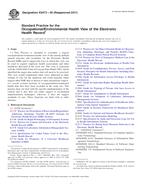
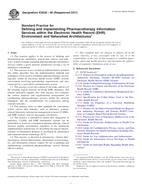 ASTM E2538-06(2011)..
ASTM E2538-06(2011)..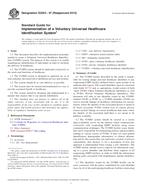 ASTM E2553-07(2013)..
ASTM E2553-07(2013)..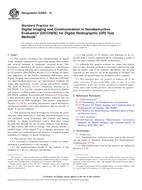 ASTM E2699-13
ASTM E2699-13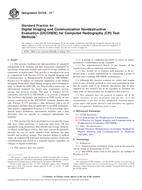 ASTM E2738-13e1
ASTM E2738-13e1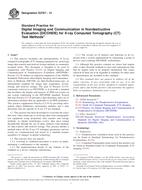 ASTM E2767-13
ASTM E2767-13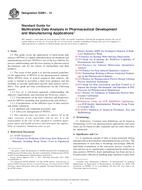 ASTM E2891-13
ASTM E2891-13
 Cookies
Cookies
